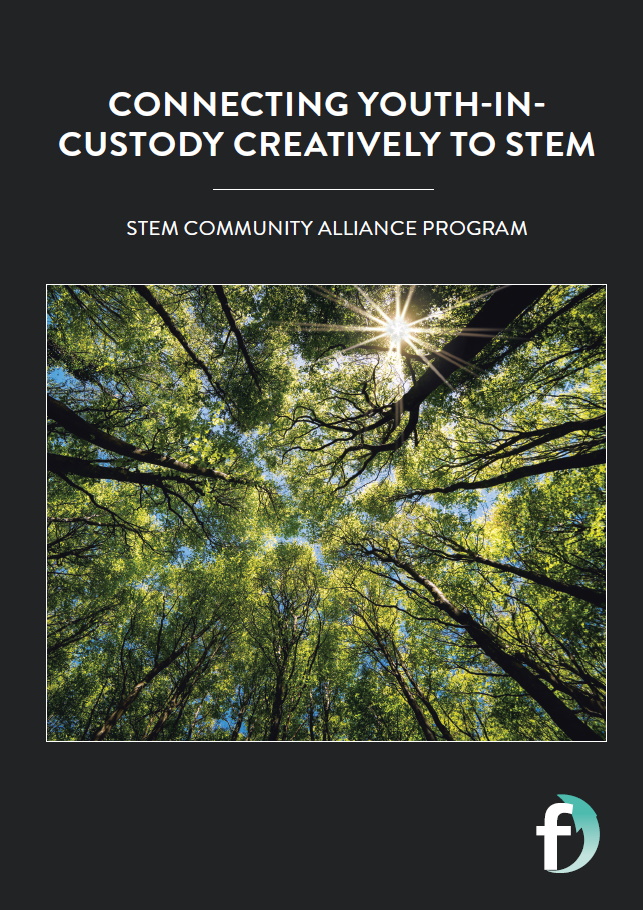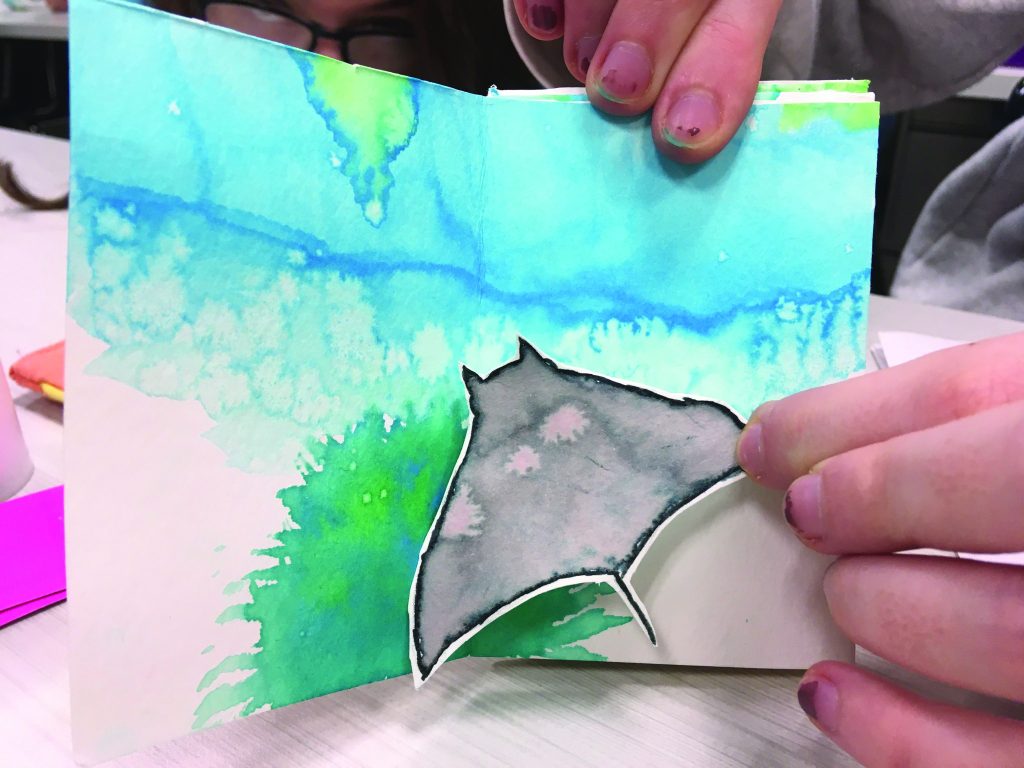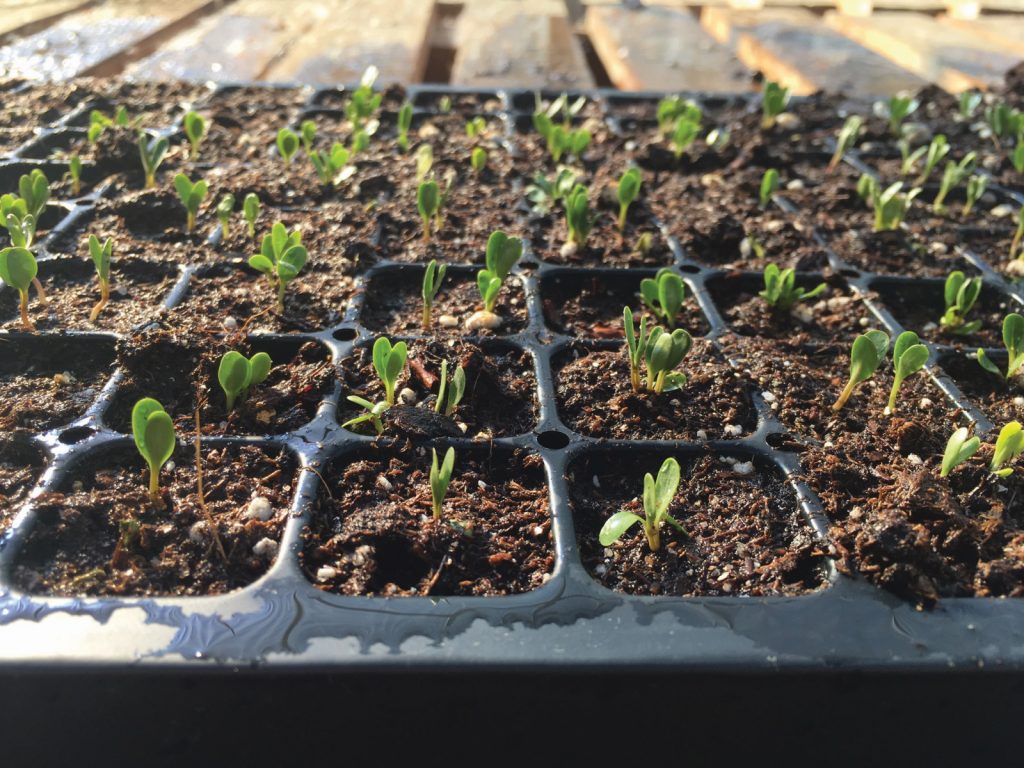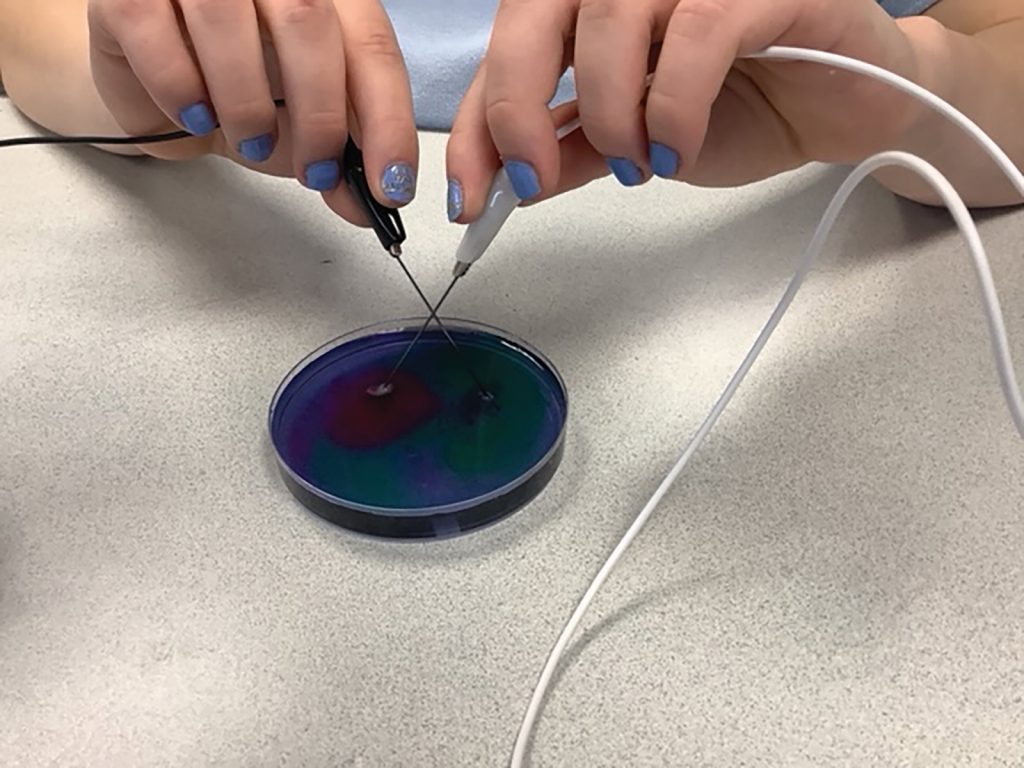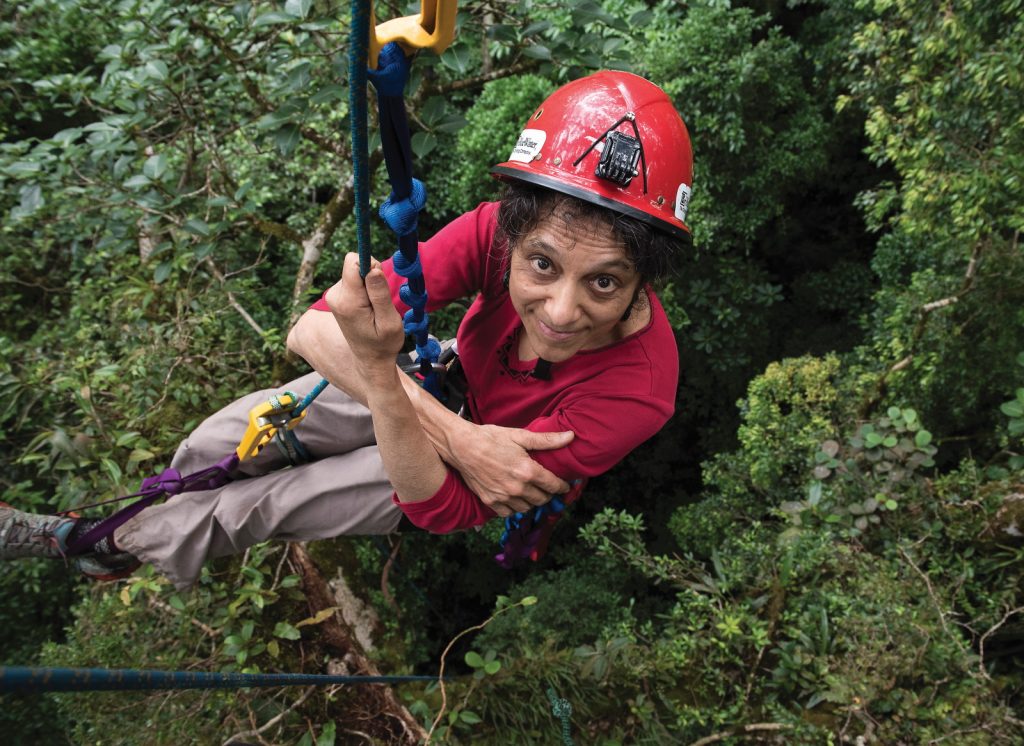Connecting youth-in-custody creatively to STEM
Nalini Nadkarni, a professor at the University of Utah in the US, has made amazing discoveries in the tops of trees, but now her focus is on sharing science and nature with every corner of the community. Teaming up with Program Manager Laura George, Nalini runs the STEM Community Alliance Program, which connects scientists to youth-in-custody
It might not be your first concern if you were sent to prison, but there are no trees there. If there were, the branches would obscure the officers’ view. But can you imagine living in a world of bare concrete walls, devoid of any vegetation?
Having spent more time than most climbing trees as a canopy researcher, Professor Nalini Nadkarni saw this as a problem. How were incarcerated individuals supposed to become well-adjusted members of society without having a connection with nature? So, she started working to bring the plants to the incarcerated, involving them in conservation projects and delivering a series of science lectures. Then, in 2017, the Utah State Board of Education asked Nalini if she could start something similar for youth-in-custody.
WHO ARE YOUTH-IN-CUSTODY?
In Utah, youth-in-custody (YIC) means anybody under the age of 21 who is looked after by the state or a Native American tribe, or is being held in a detention facility. Young people can end up in custody for a variety of reasons, including crime, addiction to drugs and mental health problems.
While it is the law that all YIC have access to education, there was no doubt in Nalini’s mind that more needed to be done to give these young people better opportunities. To her, a creative connection to science, technology, engineering and maths (STEM) could be the key to a brighter future.
WHY IS ACCESS TO STEM IMPORTANT FOR YIC?
The goal of the juvenile detention centres and residential treatment centres in Utah is to help YIC become independent and re-integrate into society. Because STEM is important in society, it is a crucial part of their education. “Access to quality STEM education is essential to equip all people – especially young people – with the tools and experiences to effect change in an evolving society, promote innovation, prepare for employment opportunities and stimulate lifelong learning,” says Nalini.
Nalini’s response to the Board of Education’s request was to create the STEM Community Alliance Program, or STEMCAP. Through this programme, academic scientists present their work to YIC and become directly involved with science lessons. Bringing these professional scientists into the classroom not only enriches the content of the curriculum, but also gives the YIC a chance to learn about careers they may not have heard about before.
WHY DOES STEMCAP FOCUS ON ENVIRONMENTAL ISSUES?
Although STEMCAP covers a broad range of STEM disciplines, and also incorporates the arts, humanities and social sciences, the environment is a central theme. The reasoning behind this is that environmental issues involve us all. Whether you are talking about climate change, biodiversity loss or pollution, the solutions are never down to one person: they require collective action. By feeling involved in these collective efforts, YIC can start to feel more confident about their role in society.
Laura George is Program Manager for STEMCAP. “Environmental issues transcend science and threaten our wellbeing,” she says. “We want YIC to know they deserve a voice, to feel they can be a part of working toward something positive.” STEMCAP even gives YIC students the opportunity to work on conservation projects alongside other community members and scientists. Laura explains, “The results of the work students put in are tangible, so they get a sense of success from these projects. It is not so much about the environmental content, as it is about how these issues can bring people together.”
WHAT IS IT LIKE TEACHING AT A YOUTH-IN-CUSTODY CENTRE?
Teachers can find it challenging to work in YIC centres because of strict safety requirements. While their top priority is delivering a good lesson, the staff at the centre are focused on keeping everybody safe. This means that the classroom cannot contain materials that could hurt people, which can include anything made of metal or glass. In some places, even everyday objects such as permanent markers and paintbrushes are banned.
As well as having to be creative when it comes to materials, teachers need to be flexible. “Security lockdowns and other last-minute schedule changes can make it impossible to predict when students will be in the classroom,” says Laura.
Despite these challenges – or perhaps because of them – the presenters involved in STEMCAP have said their experiences working at YIC centres have been rewarding, both personally and professionally. The presenters also realised that their assumptions about YIC were wrong when they saw how engaged the students were in their lessons.
WHAT NEXT FOR STEMCAP?
The evidence so far shows that STEMCAP is a success. When the Utah Education Policy Center reviewed the programme, they found that the YIC showed high levels of interest and curiosity during lessons. Perhaps even more importantly, they saw students getting a better sense of who they were and how they could contribute to society.
Laura hopes that STEMCAP can inspire similar programmes across the US. They have already written a handbook that describes how STEMCAP works, which can be sent to other institutions around the country as inspiration.
 PROFESSOR NALINI NADKARNI
PROFESSOR NALINI NADKARNI
STEMCAP Program Director and Professor of Biology
University of Utah, USA
EXPERTISE: Canopy Ecology, Forest Conservation and Science Communication
Known as the “Queen of the Canopy”, Nalini has spent much of her career climbing into the upper reaches of trees to study the plant life there. It was also her idea to create the STEM Community Alliance Programme (STEMCAP), which gives incarcerated youths access to art and science.
FUNDERS: National Science Foundation (NSF), Utah State Board of Education
 LAURA GEORGE
LAURA GEORGE
STEMCAP Program Manager
University of Utah, USA
EXPERTISE: Environmental Humanities
For her master’s degree, Laura researched how to make environmental education more inclusive. She now manages the Initiative to Bring Science Programs to the Incarcerated (INSPIRE) as well as STEMCAP.
For questions about STEMCAP, or to get involved as a presenter, visit STEMCAP.org or contact Laura at [email protected].
WHAT DOES STEMCAP DO?
TOPICAL PRESENTATIONS
Topical presentations introduce YIC to the STEM community. Each presentation teaches students about some cutting-edge science, but the most important thing is not the science itself. Instead, the aim is really to showcase the diversity of people involved in science, and demonstrate the fact that it is current and dynamic. “We hope students take away that there are people in their community engaging in science in a variety of ways, and that those people do not all look the same or come from the same backgrounds,” says Laura.
As well as talking about their research, presenters are encouraged to discuss struggles they had in school and the unique paths that led them into science. This shows students that not all scientists were perfect school students who always knew what they wanted to do.
Interestingly, not all of the presenters are scientists. Artists, writers and community members who engage with STEM in non-professional ways also contribute, showing the students that there are many different ways to be involved in STEM.
MISSION STEMCAP
Students involved in Mission STEMCAP address one of five “Grand Challenges”. The Grand Challenges were selected by a group of scientists at Stanford University in the US, who believe they are the biggest threats that humans face right now: extinction, biodiversity loss, climate change, pollution and overconsumption.
Over the course of two weeks, students learn about one of the Grand Challenges with STEMCAP staff and guest presenters from a wide variety of backgrounds. They are then asked to respond to the challenge and talk about it with each other and members of the community. The aim is to show the importance of collaboration: all of the challenges can only be overcome if people work together. Furthermore, Laura says, “Mission STEMCAP empowers youth by giving them a voice, and showing them ways to use that voice for a cause they care about”.
CONSERVATION PROJECTS
STEMCAP runs three conservation projects. In one, YIC grow milkweed in a greenhouse, a plant that is crucial to the survival of monarch butterflies. In another, they work with the Salt Lake City Seed Library to help preserve heirloom varieties of plants. The third project introduces students to citizen science – research projects that rely on online participation from members of the public.
“These long-term projects build student confidence as they begin to see positive results of the work they put in,” says Laura. “They also show members of the local community that YIC are capable of and interested in conservation work.”
Reference
https://doi.org/10.33424/FUTURUM231
Cyanotypes created by YIC using photosensitive paper they made by mixing two different ferric chemicals during a STEMCAP art-science workshop. You can do the same by following these simple instructions by Instructables:
www.instructables.com/Cyanotypes—super-easy-photo-prints-at-home.
Milkweed sprouts raised by YIC in their centre’s greenhouse as part of a STEMCAP conservation project. Find out how to grow milkweed from seed: www2.illinois.gov/dnr/education/Pages/SeedInstr.aspx
A YIC student splits water molecules using electrolysis as part of a Science Right Now workshop. With the supervision of your teacher, you can also conduct this activity: www.instructables.com/Separate-Hydrogen-and-Oxygen-from-Water-Through-El
Having spent more time than most climbing trees as a canopy researcher, Professor Nalini Nadkarni saw this as a problem. How were incarcerated individuals supposed to become well-adjusted members of society without having a connection with nature? So, she started working to bring the plants to the incarcerated, involving them in conservation projects and delivering a series of science lectures. Then, in 2017, the Utah State Board of Education asked Nalini if she could start something similar for youth-in-custody.
WHO ARE YOUTH-IN-CUSTODY?
In Utah, youth-in-custody (YIC) means anybody under the age of 21 who is looked after by the state or a Native American tribe, or is being held in a detention facility. Young people can end up in custody for a variety of reasons, including crime, addiction to drugs and mental health problems.
While it is the law that all YIC have access to education, there was no doubt in Nalini’s mind that more needed to be done to give these young people better opportunities. To her, a creative connection to science, technology, engineering and maths (STEM) could be the key to a brighter future.
WHY IS ACCESS TO STEM IMPORTANT FOR YIC?
The goal of the juvenile detention centres and residential treatment centres in Utah is to help YIC become independent and re-integrate into society. Because STEM is important in society, it is a crucial part of their education. “Access to quality STEM education is essential to equip all people – especially young people – with the tools and experiences to effect change in an evolving society, promote innovation, prepare for employment opportunities and stimulate lifelong learning,” says Nalini.
Nalini’s response to the Board of Education’s request was to create the STEM Community Alliance Program, or STEMCAP. Through this programme, academic scientists present their work to YIC and become directly involved with science lessons. Bringing these professional scientists into the classroom not only enriches the content of the curriculum, but also gives the YIC a chance to learn about careers they may not have heard about before.
WHY DOES STEMCAP FOCUS ON ENVIRONMENTAL ISSUES?
Although STEMCAP covers a broad range of STEM disciplines, and also incorporates the arts, humanities and social sciences, the environment is a central theme. The reasoning behind this is that environmental issues involve us all. Whether you are talking about climate change, biodiversity loss or pollution, the solutions are never down to one person: they require collective action. By feeling involved in these collective efforts, YIC can start to feel more confident about their role in society.
Laura George is Program Manager for STEMCAP. “Environmental issues transcend science and threaten our wellbeing,” she says. “We want YIC to know they deserve a voice, to feel they can be a part of working toward something positive.” STEMCAP even gives YIC students the opportunity to work on conservation projects alongside other community members and scientists. Laura explains, “The results of the work students put in are tangible, so they get a sense of success from these projects. It is not so much about the environmental content, as it is about how these issues can bring people together.”
WHAT IS IT LIKE TEACHING AT A YOUTH-IN-CUSTODY CENTRE?
Teachers can find it challenging to work in YIC centres because of strict safety requirements. While their top priority is delivering a good lesson, the staff at the centre are focused on keeping everybody safe. This means that the classroom cannot contain materials that could hurt people, which can include anything made of metal or glass. In some places, even everyday objects such as permanent markers and paintbrushes are banned.
As well as having to be creative when it comes to materials, teachers need to be flexible. “Security lockdowns and other last-minute schedule changes can make it impossible to predict when students will be in the classroom,” says Laura.
Despite these challenges – or perhaps because of them – the presenters involved in STEMCAP have said their experiences working at YIC centres have been rewarding, both personally and professionally. The presenters also realised that their assumptions about YIC were wrong when they saw how engaged the students were in their lessons.
WHAT NEXT FOR STEMCAP?
The evidence so far shows that STEMCAP is a success. When the Utah Education Policy Center reviewed the programme, they found that the YIC showed high levels of interest and curiosity during lessons. Perhaps even more importantly, they saw students getting a better sense of who they were and how they could contribute to society.
Laura hopes that STEMCAP can inspire similar programmes across the US. They have already written a handbook that describes how STEMCAP works, which can be sent to other institutions around the country as inspiration.
 PROFESSOR NALINI NADKARNI
PROFESSOR NALINI NADKARNI
STEMCAP Program Director and Professor of Biology
University of Utah, USA
EXPERTISE: Canopy Ecology, Forest Conservation and Science Communication
Known as the “Queen of the Canopy”, Nalini has spent much of her career climbing into the upper reaches of trees to study the plant life there. It was also her idea to create the STEM Community Alliance Programme (STEMCAP), which gives incarcerated youths access to art and science.
FUNDERS: National Science Foundation (NSF), Utah State Board of Education
 LAURA GEORGE
LAURA GEORGE
STEMCAP Program Manager
University of Utah, USA
EXPERTISE: Environmental Humanities
For her master’s degree, Laura researched how to make environmental education more inclusive. She now manages the Initiative to Bring Science Programs to the Incarcerated (INSPIRE) as well as STEMCAP.
For questions about STEMCAP, or to get involved as a presenter, visit STEMCAP.org or contact Laura at [email protected].
TOPICAL PRESENTATIONS
Topical presentations introduce YIC to the STEM community. Each presentation teaches students about some cutting-edge science, but the most important thing is not the science itself. Instead, the aim is really to showcase the diversity of people involved in science, and demonstrate the fact that it is current and dynamic. “We hope students take away that there are people in their community engaging in science in a variety of ways, and that those people do not all look the same or come from the same backgrounds,” says Laura.
As well as talking about their research, presenters are encouraged to discuss struggles they had in school and the unique paths that led them into science. This shows students that not all scientists were perfect school students who always knew what they wanted to do.
Interestingly, not all of the presenters are scientists. Artists, writers and community members who engage with STEM in non-professional ways also contribute, showing the students that there are many different ways to be involved in STEM.
MISSION STEMCAP
Students involved in Mission STEMCAP address one of five “Grand Challenges”. The Grand Challenges were selected by a group of scientists at Stanford University in the US, who believe they are the biggest threats that humans face right now: extinction, biodiversity loss, climate change, pollution and overconsumption.
Over the course of two weeks, students learn about one of the Grand Challenges with STEMCAP staff and guest presenters from a wide variety of backgrounds. They are then asked to respond to the challenge and talk about it with each other and members of the community. The aim is to show the importance of collaboration: all of the challenges can only be overcome if people work together. Furthermore, Laura says, “Mission STEMCAP empowers youth by giving them a voice, and showing them ways to use that voice for a cause they care about”.
CONSERVATION PROJECTS
STEMCAP runs three conservation projects. In one, YIC grow milkweed in a greenhouse, a plant that is crucial to the survival of monarch butterflies. In another, they work with the Salt Lake City Seed Library to help preserve heirloom varieties of plants. The third project introduces students to citizen science – research projects that rely on online participation from members of the public.
“These long-term projects build student confidence as they begin to see positive results of the work they put in,” says Laura. “They also show members of the local community that YIC are capable of and interested in conservation work.”
STEMCAP BY THE NUMBERS
7,000: The number of youth-in-custody in the state of Utah, 2019
3X: Black youths were three times more likely to be put into custody in 2017 than other racial groups
197: Workshops completed by STEMCAP to date
188: Guest presenters for STEMCAP, including artists, scientists, conservationists, writers and engineers
8: YIC centres reached
MEET NALINI
When I was a kid – who frequently climbed trees in my backyard – I wanted to be a grown-up who helped nature, especially trees. I thought I might become a forest fire-fighter or a park ranger, but when I learned about the field of ecology in college, I decided to become a forest ecologist and help trees by better understanding their biology and ecology.
My love of being in nature inspired me to study biology, and wanting to somehow ‘payback’ nature – especially trees – because they provided me with such joy and beauty. I believe everyone can benefit from involvement in science and nature, particularly those who are denied access to them because of physical, financial or cultural barriers. And I believe that academics can benefit from exposure to people outside of science, by becoming more aware of different viewpoints and ways of knowing. So, while I love carrying out research about forests, I get an equal sense of fulfilment communicating science to people who do not have access to traditional education venues like schools and museums.
In 2003, I began the Sustainability in Prisons Program in Washington State, to bring science lectures and conservation projects to incarcerated adults in state prisons. After I moved to Utah in 2011, I started a project called Initiative to Bring Science Programs to the Incarcerated (INSPIRE), and then eventually STEMCAP in 2017. The achievements that I value the most are those that create something new, something different. Something potentially transformative. These include being the parent of two children, and starting programmes that have brought scientists into meaningful contact with the incarcerated, faith groups, urban youth and policy-makers.
Try to identify your pre-conceptions of YIC so you can approach them with an open mind. Even though we tend to think of incarceration as a bad thing that must be eliminated, youth-in-custody really benefit from being in facilities with dedicated teachers and resources that they would otherwise not have access to. I also recommend that you should be as truthful as you can when you interact with YIC, because that is what so many of them have not had in their lives.
MEET LAURA
Growing up I wanted to be a vet because I loved animals. I eventually discovered that being a vet can be hard because you often see pets you cannot help and have to put them to sleep. When I was in high school, I wanted to be an author or an English teacher.
For my undergrad, I majored in English and minored in ecology at the University of Georgia in the US. I chose these areas of study because I love fiction and poetry, but I am also very passionate about the outdoors, environmentalism and plants.
I then decided the environmental humanities master’s programme at the University of Utah was a great way to combine my love of writing with my interest in the natural world. At Utah, I created an environmental education curriculum that centred on plants and connected to urban ecosystems. The idea was to make it accessible to students in Salt Lake Valley, who have fewer opportunities to explore more remote environments. I then worked to present my curriculum to underserved youth around the valley.
I believe that connection to nature is healing, and that familiarity with your environment is empowering. But environmental education is not generally a priority in schools, which means only kids whose parents have the interest and money to send them to summer or after school programmes have access to it.
I also feel strongly that environmental education is needed to address climate change, pollution and biodiversity loss. The Earth is our home, and we all rely on it, so I believe that it is only fair to ensure everybody gets a good environmental education and has the power to protect their planet.
I plan to continue managing STEMCAP for a few more years. In that time, I want to bring STEMCAP to other states, publish more research on our work, and create a programme to help students continue engaging with STEM once they are released from custody or have graduated from high school and no longer attend class at YIC centres.
Don’t be afraid to combine your interests and forge your own path. I was often told that English and ecology were too different, and that I should pick one or the other. Also, be aware that contributing to STEM and protecting the environment can take many different forms. Don’t shy away from STEM just because you don’t see yourself as a scientist. Science is everywhere, and we are all scientists in our own way.
Do you have a question for the Nalini or Laura?
Write it in the comments box below and Nalini or Laura will get back to you. (Remember, researchers are very busy people, so you may have to wait a few days.)

